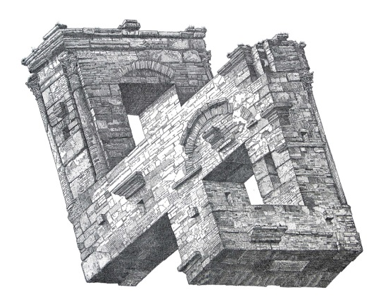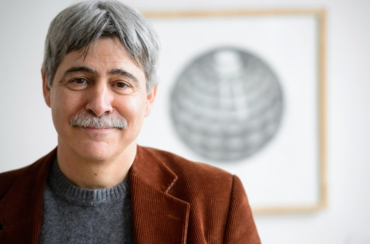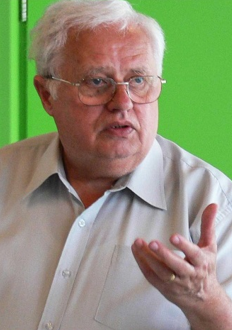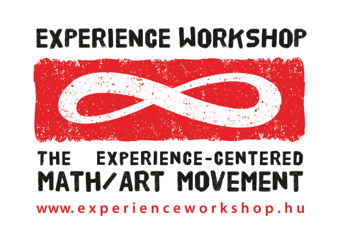István Orosz & Lajos Szilassi: VIVID SPIRIT
VIVID SPIRIT
Exhibition by
István Orosz (HU) artist & Lajos Szilassi (HU) mathematician
Curated by Kristóf Fenyvesi (University of Jyväskylä – Experience Workshop)
in the framework of Bridges Finland 2016: University of Jyväskylä
www.bridgesmathart.org
Venue: Näyttelykeskus Soihtu (Soihtu Exhibition Center at University of Jyväskylä Campus)
Address: Jyväskylä, Seminaarinmäki, S-rakennus (S-building)
Opening time: 9 August – 30 September, 2016, Tu-Fri: 12.00-17.00, Sat: 12.00-16.00
Meet the mathematician, Lajos Szilassi at the exhibit: 12 August, 2016, 19.00
Free entrance!
"The characteristic of the vivid spirit,
that it is enough for her to see and hear very little,
for being able to understand a lot."
-- Giordano Bruno

It might be interesting to see together the name of a graphic artist and a mathematician in the program of an art exhibition. However, this would not explain in itself how our exhibitors have met and felt an intellectual relationship, to such an extent that it gave rise to the idea of a joint exhibition.
The works of the graphic artist István Orosz are verge on mathematics, while those of the mathematician Lajos Szilassi are verge on art.
 One can observe a kind of reciprocity between the work of the two originators. István Orosz depicts non-existing and non-producible spatial figures, so convincingly that we feel they still exist. Lajos Szilassi has produced –he would rather say, as a devotee of Platonism, discovered –spatial figures (solids bounded by flat faces) of which, if we did not see them with our own eyes, we would think that they cannot exist. Briefly, István deceives, Lajos takes aback (one might also say, astounds) the viewer.
One can observe a kind of reciprocity between the work of the two originators. István Orosz depicts non-existing and non-producible spatial figures, so convincingly that we feel they still exist. Lajos Szilassi has produced –he would rather say, as a devotee of Platonism, discovered –spatial figures (solids bounded by flat faces) of which, if we did not see them with our own eyes, we would think that they cannot exist. Briefly, István deceives, Lajos takes aback (one might also say, astounds) the viewer.
 István Orosz (born in 1951 in Kecskemét) is Hungarian painter, printmaker, graphic designer and animated film director. Studied at the Hungarian University of Arts and Design (now Moholy-Nagy University) in Budapest as pupil of Ernő Rubik. After graduating in 1975 he began to deal with theatre as stage designer and animated film as animator and film director. The mathematically inspired works of István Orosz, with forced perspectives and optical illusions, has been compared to works by M. C. Escher.
István Orosz (born in 1951 in Kecskemét) is Hungarian painter, printmaker, graphic designer and animated film director. Studied at the Hungarian University of Arts and Design (now Moholy-Nagy University) in Budapest as pupil of Ernő Rubik. After graduating in 1975 he began to deal with theatre as stage designer and animated film as animator and film director. The mathematically inspired works of István Orosz, with forced perspectives and optical illusions, has been compared to works by M. C. Escher.
Themes of the natural sciences, especially of geometry and optics appear in most of his works. He is also concerned with the theories of vision and sight such as the way the beholder’s hypothetical expectations influence the visual and empirical perception of spatial constructions. He is likely to experiment with the extremes, paradoxes of the representation of the perspective to create the illusion of space. Also he does experiements to renew the techniques of anamorphosis when he distorts the pictures in such a way that it can only be seen from a particular aspect or in such a way that its new layer of meaning only reveals by the interposition He often uses OYTIΣ, or Utisz, (pronounced: outis) (No one) as artist's pseudonym.
 Lajos Szilassi (born in 1942 in Szentes, Hungary) is a Hungarian mathematician and college professor. His main fields of research are geometry, including projective and non-Euclidean geometry.
Lajos Szilassi (born in 1942 in Szentes, Hungary) is a Hungarian mathematician and college professor. His main fields of research are geometry, including projective and non-Euclidean geometry.
The Szilassi-polyhedron is named after him. It is a toroidal polyhedron with seven hexagonal faces, each pair of which share an edge; he published a paper describing it in 1986.
Completed secondary school teaching degree in 1966 in mathematics and descriptive geometry majoring in the Bolyai Institute of University of Szeged. Following a six-year period as a grammar school teacher, he taught at a teacher training college until his retirement.
Nowadays, due to the development of computer aided modeling, it only takes some seconds to perform experiments which formerly needed several weeks. This makes possible to implement the earlier methods so as to discover new polyhedra closely related to the original examples. The mathematical content and the wealth of the forms of these new spatial figures suggest that it is worth to prepare sculptures from them made of stainless steel. We present these polyhedron sculptures in the exhibition.
Educational co-ordination of the exhibit is provided by
